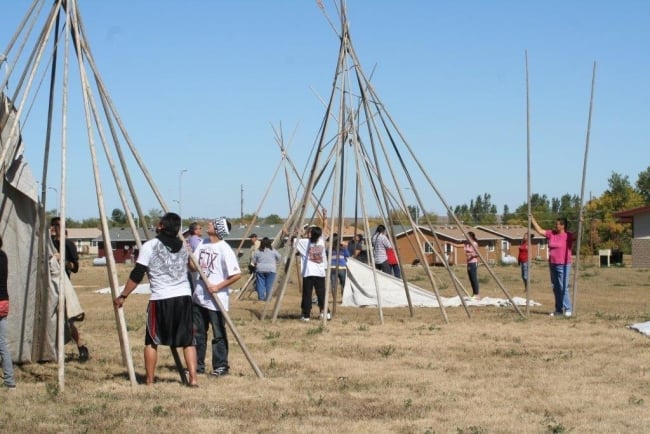You have /5 articles left.
Sign up for a free account or log in.

Sitting Bull College
At Fort Peck Community College, which serves an isolated rural community in northeastern Montana, attracting and retaining talented instructors has never been easy. But this year, the financial stability of the tribally controlled college is even more uncertain, since across-the-board federal spending cuts have eliminated significant funding on which it depends.
Due to sequestration, instead of being able to hire quality math and science instructors — which it needs — the college is struggling to keep its current faculty on board. Faculty members are experiencing pay freezes and being offered short-term contracts, as well as being assigned multiple roles, said Mark Sansaver, who is the college’s grants manager. Sansaver said he does not yet know how many faculty members the college will lose in the upcoming school year, but he predicts Fort Peck will lose five.
“We’re just not running at full capacity,” Sansaver said.
The story is similar at the 36 other colleges that provide education and services for 88,000 students from more than 230 federally recognized Indian tribes. The federal spending cuts that went into effect in March could have harmful effects for K-12 schools as well as public colleges. Many research universities are also frustrated by the cuts -- but they are particularly painful for tribal colleges, which depend on federal programs for operating support and which typically lack much in the way of state funds or endowments to serve largely low-income students.
The Universities Assistance Act of 1978 provides the majority of operations funds for tribal colleges, said Cheryl Crazy Bull, president of the American Indian College Fund. Tribal colleges are also dependent on competitive grants offered from federal agencies such as the National Endowment for the Humanities and the National Science Foundation. So cuts to the Act and those agencies will cause tribal colleges to close programs and cut courses, Crazy Bull said.
“And this occurs in environments where tribal colleges are the only option for students,” she said.
Faculty and staff at these institutions are already underpaid compared with their peers elsewhere, she said. At United Tribes Technical College in North Dakota, for example, human resource director Barbara Little Owl said faculty members make, on average, between $40,000 and $45,000. At community and technical colleges not too far away, faculty can earn up to $60,000, she said. The college is struggling to retain faculty as employees flee to higher-paying positions. According to data from the American Indian Higher Education Consortium, the average salary of an American Indian faculty member at a tribal college is $38,762 to $41,271. The average salary for an instructor at North Dakota State is $53,300, according to 2012 data from the American Association of University Professors.
At the American Indian Higher Education Consortium’s 40th anniversary conference, which took place last week in New Mexico, Crazy Bull said, the tribal college presidents shared their worries aloud.
“They spoke to their deep concerns — almost fear — that they will end up with a 30 percent cut in operations,” she said.
Fort Peck receives around 85 percent of its operating budget from programs within the Education Department and from federal grants. The college’s operating budget is around $11 million, but it could end up losing 10 to 20 percent of that in the upcoming academic year.
The creation of Fort Peck’s new library, information technology center and tribal archive depository — an $8 million project — was paid for by general funds and loans. The library is open, but the college is now scrambling to find funding to fill the “empty shell” of the other two spaces with desks, chairs and white boards.
“We’ve been real frugal with anything moving forward,” Sansaver said. “We had a rainy day fund. And, well, that rainy day came.”
Sitting Bull College in Fort Yates, North Dakota is cutting back on staff to deal with the effects of federal budget cuts, said President Laurel Vermillion. When a resource development director recently resigned, the college did not have the funds to fill the position. Around 60 percent of Sitting Bull's $11 million overall budget comes from federal funding, said Leonica Alkire, Sitting Bull's vice president of finance. The college receives $5 million in federal grants that is subject to sequester cuts, and Alkire said she is expecting a 5 percent cut in the college's budget.
Vermillion said she worries that her staff will burn out, as many of them are taking on two or three different roles at the college.
“At the tribal colleges we have dedicated staff and faculty. They fall in love with not only the college but with the students and community,” Vermillion said. “If we don’t have additional dollars to hire additional people, someone has to do the work.”
As the summer comes to an end, some tribal college officials are still waiting to find out how much funding they will receive for the upcoming year. They are holding their breath as their colleges struggle to stay afloat. At United Tribes Technical College, executive vice president Russell Swagger said the college is preparing for the “worst-case scenario.” The college already eliminated one of its two summer sessions this year, due to lack of funding. And it is becoming more difficult to retain quality staff and students, Swagger said, as college officials cannot tell them with certainty that the doors of Untied Tribes will be able to remain open in the years ahead.
“It’s kind of an awkward message to send to people, that we’re doing the best we can, but we don’t know for sure what will happen,” Swagger said.
The Long-Term Impact
Tribal colleges play a vital role in Indian country, and without a full set of resources, there could be detrimental effects for their students as well as the surrounding tribal community members they serve, said Meg Goetz, vice president for advocacy at the American Indian Higher Education Consortium.
Many American Indians have family obligations, and cannot easily leave their reservations even if they would like to. Tribal colleges are also more culturally accessible to Native students, who may be uncomfortable at a university away from home, Goetz said. A student who wants to attend a college or university away from an Indian reservation is likely to be more successful if he starts out at a tribal college, Goetz said.
The colleges are also an affordable, attractive option for students who are not members of federally recognized tribes, Crazy Bull said.
And they have a significant economic impact in their community. Sitting Bull College’s Vermillion said that cutting summer programs means that cafeteria servers, maintenance workers and faculty are suddenly jobless. “It’s a real domino effect,” she said. “The colleges are a dominant employer in the reservations. So when they cancel programs it has a really big effect all around.”
Besides providing jobs, tribal colleges provide much-needed community outreach services, food and nutrition services, wellness programs and GED classes. These programs are often the first to go when funding is short.
Some of the tribally controlled colleges are seeking help from their tribes to help ensure programs do not disappear. It was rumored earlier in the spring that Fort Peck Community College would have to do away with its wellness programs, but it worked with the Fort Peck Tribes to increase funding and was able to retain them, Sansaver said.
United Tribes Technical College’s Swagger said the North Dakota state legislature as well as organizations such as AIHEC have been very supportive.
“And I just know that if funding goes in the other direction, it would mean having a greater impact in tribal communities and being able to help students move back into their communities and make significant and profound change,” he said.








